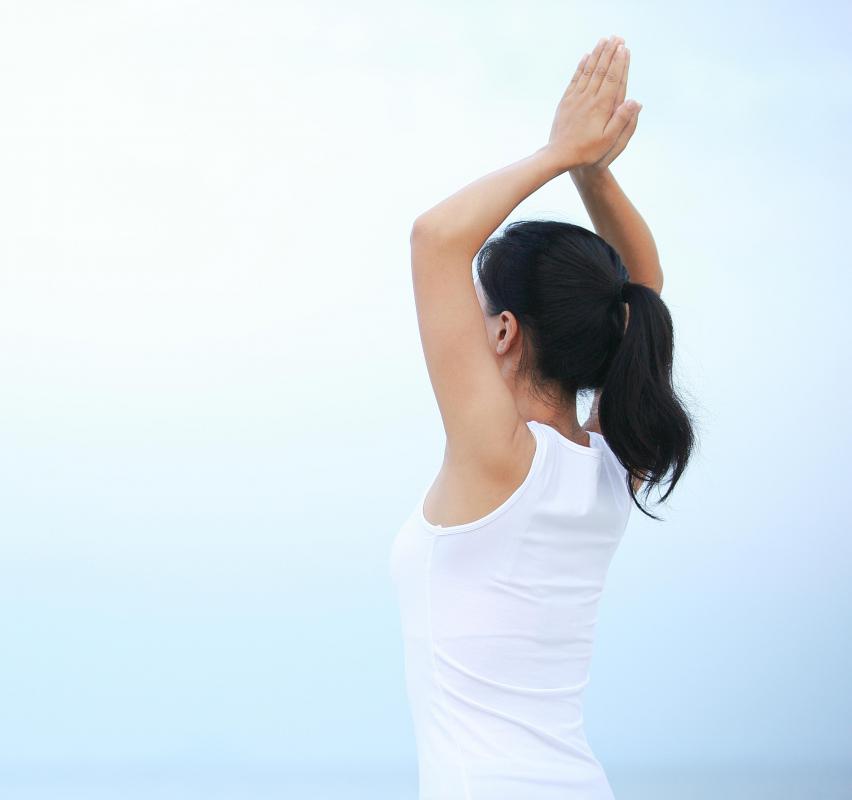At WiseGEEK, we're committed to delivering accurate, trustworthy information. Our expert-authored content is rigorously fact-checked and sourced from credible authorities. Discover how we uphold the highest standards in providing you with reliable knowledge.
What Are the Five Tibetan Rites?
The five Tibetan rites are an ancient yoga exercise routine. Their earliest known publication was in The Eye of Revelation, published in 1939 by Peter Kelder. Unlike Indian based yoga practices, the five Tibetan rites require the participant to be in a state perpetual movement. Some doubt has been expressed as to the validity of the rites, as no Tibetans have confirmed their authenticity.
Kelder’s booklet is an account of a conversation with an anonymous traveler, allegedly a retired British Army Colonel. At an unspecified time in the early 1900s, Colonel Bradford, the pseudonym given to this anonymous traveler by Mr. Kelder, journeyed to Tibet after his retirement in search of a fabled lamasery, which he had heard contained a fountain of youth. Kelder claimed that Bradford had found this lamasery, where he was instructed in five rites that were supposed to give the participant strength and virility along with a sixth rite that included a breathing exercise.

The interaction of the five Tibetan rites with the body was explained to Bradford, and subsequently Kelder, as a way to maintain the appropriate spinning motion of the seven vortexes within the human body. Kelder's booklet refers to them as psychic vortexes, and they are located at seven vital points on the human body, according to Tibetan beliefs. The rites have the power to restore the vortexes to their original state and speed, opposing the slowing tendency that the booklet claims accompanies old age.

The first rite requires the participant to spin in circles, clockwise, while standing with arms parallel to the ground. The second is conducted while lying down. The practitioner, while keeping his hands close to his sides, lifts his legs until they are perpendicular to the floor. The knees should remain unbent during this exercise. After keeping the legs straight and suspended for a short interval, they are gently lowered again and the process repeated after a small window of relaxation.
Throughout the third rite, the hands are pressed against the practitioner's sides, and he remains in a kneeling position with the feet tucked beneath the body. The first half of the rite requires the practitioner to bend at the waist and lean forward as far as he can, endeavoring to keep the chin pressed against the chest. During the latter half, the practitioner leans back, again bending at the waist as far as possible. After both halves of the exercise are complete, the torso is returned to an upright position. The exercise begins again following rest.
The fourth rite begins seated with both hands flat on the floor to each side and the legs extended straight. The back of the knees should make contact with the floor as well. The torso is raised up until the legs, from the feet to the knees, as well as the arms, are nearly perpendicular to the ground, rendering the body parallel to the floor. The head is hung back as far as it can go, and the position is maintained for a few minutes until the body is released and allowed to relax.
For the last of the five Tibetan rites, the body is placed in a push-up position with the hands and feet each placed 2 feet (60 cm) apart. The torso and buttocks are raised and held well above the shoulders with the head hung low to the chest. Following this motion, the body is allowed to droop while remaining raised off the ground and with the head lifted.
AS FEATURED ON:
AS FEATURED ON:












Discussion Comments
Regardless of what they call it, if it's yoga it's a religion. It's now extremely easy to find the truth. Many gurus and yogis readily admit this. Before a person gets too involved in this they owe it to themselves to investigate.
Post your comments